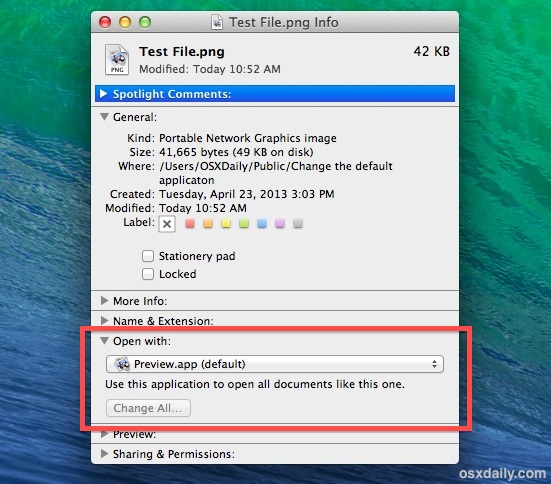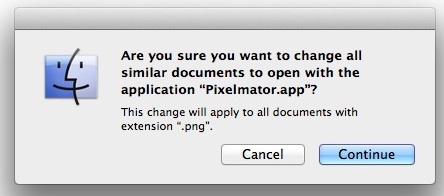2 Ways to Change the Default Application to Open Files With in Mac OS X

Each file type has a default application that is associated with it on the Mac. This means that when you double-click a file from the Finder it will open a specific application, for example on a fresh Mac OS installation, all image files (png, jpg, gif, pdf, etc) will default to opening in Preview, and all text documents (txt, rtf, etc) will open in TextEdit.
Over time, the default applications and file associations can change as you install more applications, which sometimes set themselves as the new default app to open a file format with.
If you want to change these default file format associations and have files open in other applications of your choosing, you’ll find there are two simple ways to do this: the first method defines the default application to launch for a specific single file, and the second method will change the application associated with all files of a given format type.
1: How to Set the Default Application for a Specific File in Mac OS
This provides file-specific control over default applications, meaning you can have a document or two that open in one app, while the overall general file type defaults to open in another application. For example, you could set one single PSD file to always open exclusively in Pixelmator, while all other PSD formatted documents continue to open in Adobe Photoshop.
- From the Mac Finder, right-click (or Control+Click) on the file to change the default app for and hold down the OPTION key so that the “Open With” menu becomes “Always Open With”
- Continue to hold OPTION and select the application you want to set as the default for this file

The file will open in the application you selected, and that file will now associate the chosen application as it’s new default to always open within.
By the way, if you’re setting a file type this way and notice duplicate entries in that Open With menu, you can remove those duplicate entries with this quick trick to clean up the Open With contextual menu.
Again, this is specific to the file you chose, and this method will not apply to all files sharing that same file format. If you want to set the default application universally for a file type, that’s what the next tip is for.
2: How to Set Default Applications to Open All Files of a Format Type in Mac OS X
This approach will change the default application universally for all files of a specific format. For example, you could use this to set all files of the type PNG to open within Skitch, all TXT files to open with TextWrangler, and all ZIP files to open with The Unarchiver.
- From the Mac file system, select a file of the general format type you wish to change the default application for
- Pull down the “File” menu and choose “Get Info” (or hit Command+i) to access the Get Info window
- Click the “Open with:” sub menu, then click on the contextual menu and select the new application to associate all files of this format type with
- Click the “Change All” button and confirm the change when requested
- Close out of Get Info, repeat for other file format types if necessary


(Note: if the Change All button is greyed out and unclickable it’s because you have not set an application that is different than the currently set default app. Use the pulldown menu to choose the new application for the Change All button to be usable and to apply the adjustment to all files of the file format type)
This change carries throughout all files of that format used within Mac OS for the active user account, and the filetype-to-application association will stay in place until it has been changed again through the same “Get Info” trick, or until a third party application claims the file format and associates with it directly.
You’ll find this one particularly useful if a newly installed application has assumed control over a file format, like what often happens with Adobe Reader claiming all PDF documents. This ‘Change All‘ trick will allow you to quickly reclaim PDF file types to reopen again in Preview (or your app of choice), which is typically much faster than launching such files in more resource heavy apps like Reader.
The video below demonstrates the latter trick, changing the default application for all files of a given type:
Note these tricks work to set the default application for files in all versions of macOS, Mac OS X, and OS X, including Big Sur, Catalina, Mojave, High Sierra, Sierra, Yosemite, El Capitan, Snow Leopard, Lion, Mountain lion, Tiger, and earlier releases too. Therefore it does not matter which version of Mac system software you are running, you can always changes the default application that opens with a file or file type.
Have any other tips or suggestions for changing application file associations on the Mac? Share in the comments!


Thanks, very helpful!
Most other sites list the first method. Unfortunately, with MacOS Monterey, even though I would associate a file with the default program I want to use to open it, after opening the file, the OS would pop up a message saying that the developer/publisher is not trusted. When this happens, the default file association doesn’t change.
The second method is exactly what I needed. Thanks again!
My privacy has been violated by an unidentified person who has an invalid and forged user agreement for my personal account. Please update my information and delete everything related to the intruder person and delete the agreement and keep your cookies and not open them in a brilliant way to any party.
This was exactly what I needed, thank you so much. I’ve been looking for how to fix this and yours was the solution that worked. THANKS!
Excellent! I was also do the necessary changes and it worked very smoothly…..Thanks a ton.
Works as of Jan. 7, 2019! Thanks for the straightforward guide.
I have a file association problem where I do not have a file to click on to set the association. I am trying ti launch a Skype For Business (SFB) meeting from my Outlook calendar and when I click on the meeting (and my default web browser is Chrome)it pops up a “finder” dialog that says “there is no application set to open the URL sfb:https://webpools…” but if I change my default web browser to Safari it works fine. Any ideas on how to fix this? I can’t right click on a file and change the association since it’s not a file but a web url…
Thank you! I downloaded Adobe Acrobat for my photoshop files but found that Acrobat kept opening my pdf documents too rather than native Preview.
It was clunky, took longer to open, and had less of the functions I loved. I spent so long trying to open docs in preview one-by-one; glad to have run by your article!
Excellent … Working perfectly on Mac 10.13.6
Highlight the file. Go to the bar at the top and look through the menu for “info” find the “open with” area, set it to all files,
confirm.
How do you change the app to open a file type without the file? You’d think this would be obvious, no?
I agree with Shawn — it seems to randomly reset itself all the time. I even deleted Acrobat Reader and Acrobat DC and now it grabs iBook. Wt…!
Thanks!
your way is correct, but not for permanent operation.
some days or system rebooting, it will change again.
i want to know how can change it permanently or FOREVER !!!!
Thanks a lot.
Did everything like you suggested and it is not working. When I go to change all it is defaulting back to the original application.
I’m trying to change the ‘open all files’ default, but the ‘open with’ submenu doesn’t appear in the ‘get info’ drop-down, both for Pages and Word (latest of each). Any other alternatives?
Tricky Question: I try to use 2 software “default” to open certain extensions, one or the other depending on the location of the files.
For example, I want the *.pdf file types in a 1 tree open with Reader and the *.pdf file type in a 2 tree open with Skim.
Do you have an idea ?
THANK YOU!!!
OSX 10.11.3 Holding Cmd whilst right-clicking on a file does NOT reveal any “Always Open With” menu.
Did you read the article? It says hold down OPTION, not Command.
Option-click (or ‘alt-click’ in this country) doesn’t do anything in High Sierra (10.13). Possibly this is new though, as I never tried it in earlier versions. The ‘Get Info’ route worked for me though :)
Same problem (as Ray). I am trying to change default for numbers (and .xls files) to v2.3 Numbers ’09 instead of v3 numbers’15 and it changes “open with” to the ’09, but then when I click on [Change All] and agree to [Continue] it reverts back to Numbers15. Is there anywhere else to change Filetype Associations?
Using OSX 10.9.5
Select the new version of Numbers to open the document with. You have to select the version you want to associate and open the document with. Then choose “Change All” once you set the latest version of Numbers for the XLS.
Why do you have a new and old version of Numbers on the same Mac anyway? That is kind of unusual, I suggest going for the newest version.
In the old Macintosh OS9 era everything went much smoother and effective.
Do you remember?? Easy it was!
Three tiny applications were conceived to do the job:
– Internet Config: Every downloaded file was assigned the opening app you declared in this table, based on the file’s MIME type and/or file extension. The ultimate solution for everybody.
– IC Typechanger: drag ‘n drop for files, to fix (based on Internet Config settings) their wrong opening app. Useful for files got from other people removable media.
– IC File Diverter: on-the-fly addressing of file opening to the app you defined in Internet Config. Works with “app-orphan” files from non-HFS CD-ROMs.
I could not get a Raw file to open with Preview, instead it was opening with Adobe Photoshop. I tried using method 1 it didn’t work. But with method 2, it seems to be working!
Thanks!
An how to set an appliction the default for all files it can open?
I have a mystery that is close to this matter.
When I receive text files or .csv files from a download, I cant select them for import into FileMaker 4.1 or Excel
The names are greyed, and unselectable.
When I export a small test file, that name is selectable for import afterwards.
Both files have same owner and rights.
Both files are text. But some restriction keeps mee from importing. Pls help.
When I make a file on a DOS/WINDOWS USB stick, I can bring it to the Mac and use Excel or Filemaker for import.
How can I tell my Mac that regardless of type, I want every file to be selectable.
Thanks,
Marc Casteels – Belgium
I agree does work, need to open old pages docs with 3.3 and tried to set that as default but returns to 5.0
Nope, this does not work. I have been struggling for some time now to force all pdf files to open in preview by default, but to no avail. Stumped.
this is great BUT it doesn’t switch the announced default in the right click Open With menu. bug? (Mac Os X 10.9.1)